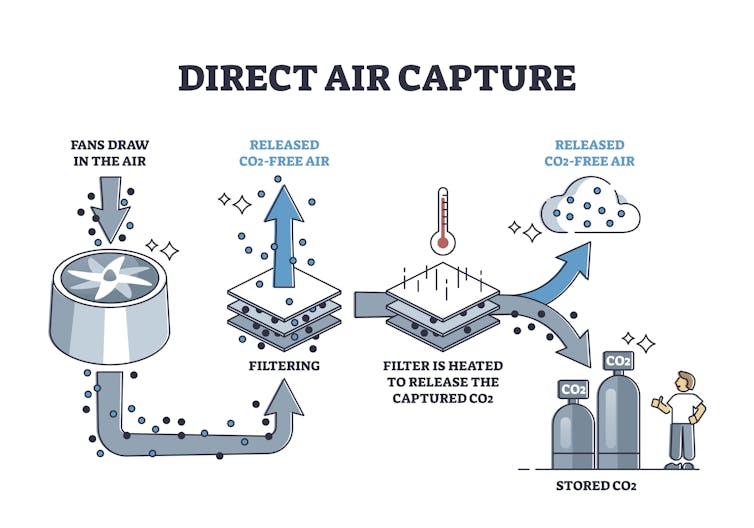Carbon offsetting isn’t working – here’s how to fix it

A blog by Professor Piers Forster, Director of the Priestley Centre
The environmental impact of carbon dioxide emissions will be the same irrespective of where the emissions take place. Carbon emitted in one part of the world can be cancelled out if the same amount is removed elsewhere.
Carbon offsetting is one way of achieving this. Companies can meet their emissions reduction targets by purchasing carbon credits awarded to projects that either emit fewer emissions at source, such as cleaner energy production, or remove them from the atmosphere, such as forestry schemes. Each credit corresponds to one metric tonne of reduced or removed carbon emissions.
The first day of the UN climate summit, COP27, in Egypt saw intense discussions over the trade of carbon offsets. The US sees offsets as a promising way of directing investment towards clean energy projects in developing countries.
But many scientists and environmentalists are sceptical of companies offsetting their emissions instead of actually reducing them. This has prompted some firms, including EasyJet, to focus their efforts on reducing their emissions directly.
I am a member of the Climate Change Committee, the UK’s independent climate change advisory body. We have produced a report that assesses whether carbon offsetting has supported the UK’s transition towards net zero. The report confirms that the scepticism around carbon offsetting is not unfounded. But we also found ways to improve offsetting.
Can we rely on carbon offsets?
Carbon credits are cheap. One tonne of carbon dioxide costs just £3 to offset on average. Companies are also not required to disclose how offsets are being used to meet their net zero targets. They therefore have little incentive to reduce their emissions as they can claim to be net zero while relying entirely on offsetting.
But offsetting often fails to reduce carbon emissions meaningfully. Global carbon credit standards exist to ensure that credits are traceable and meet a minimum verifiable level. However, an emissions reduction may occur whether or not it is paid for with credits. An area of rainforest, for example, will remove carbon from the atmosphere whether or not it has been sold as part of a carbon offsetting scheme.

Projects may also not remove emissions permanently. A fire that destroys a forest, for example, will damage the integrity of the credits sold by forestry projects. Six forest projects involved in the carbon offsetting market in California have released up to 6.8 million tonnes of carbon dioxide since 2015 because of fires.
Seeds of hope
But if used correctly, carbon offsetting can be an important component of the policy mix as we transition to net zero. A rise in the price of credits would allow offsetting to make a greater contribution to global climate priorities, such as restoring nature.
International accounting mechanisms were agreed at COP26 encouraging countries that sell offsets not to count these emissions savings towards their own climate targets. Within their borders, countries would have to deliver both their domestic targets and any offsetting projects sold to overseas buyers.
This could help raise overall climate ambition in some countries. But national climate targets for countries selling offsets need to be ambitious and the sale of offsets must be monitored to ensure the delivery of offsetting projects.
Woodland covers roughly 13% of the UK’s land surface, making it one of the most nature-depleted nations on the planet. Despite this, less than 1% of the carbon offsets purchased by the 350 largest listed companies on the London Stock Exchange go towards restoring UK nature.

However, offsetting could provide the finance required to restore UK nature. Quality standards are being developed for woodland and peatland creation projects in the UK, detailing the scale of restoration needed to deliver climate and biodiversity targets.
They require projects to last for a minimum of 70 years and demand the creation of buffers in the form of additional tree planting and peat restoration to insure against project failure. Our report suggests that these standards could lead to £1 billion of funding each year for UK nature restoration projects.
We also found that the purchase of carbon credits could raise £400 million of funding each year for emerging climate technologies in the UK. One such technology is direct air capture, which involves pulling carbon dioxide from the atmosphere and storing it underground. Purchasing credits in long-term carbon removal projects such as this represent an attractive option for industries that cannot easily curb their emissions, such as the aviation industry.

Offsets can work
Since 2018, the global market for offsets has grown five-fold and is set to continue growing. But further steps must be taken to ensure that carbon offsets are used correctly.
Guidance over how a company is using carbon offsetting must be improved. A company should only be able to claim that they are net zero when they have minimised their own emissions and are using offsetting to compensate for the rest.
The UK government is developing its own regulations for businesses through a net zero transition plan. The plan will require organisations to disclose the steps they are taking to transition towards net zero. This involves setting out how offsetting contributes to these targets, enabling an independent assessment of how far organisations are reducing their emissions.
Efforts to improve UK and international standards for carbon offsetting projects should be accelerated. Standards are being developed in the UK for carbon credits associated with restoring kelp beds off our coasts, improving carbon storage in our soils, and planting hedgerows. They will support climate and biodiversity goals while providing a financial incentive for farmers.
For overseas projects, a set of standards could be internationally agreed, possibly based on the Integrity Council for the Voluntary Carbon Market’s Core Carbon Principles. With a trusted set of standards, businesses can be confident that they are investing in high-quality offsetting projects.
Carbon offsetting should support attempts to reduce an organisation's emissions, not provide an alternative. By improving guidance on the use of offsetting, businesses can be encouraged to reduce their emissions directly. But through financing climate change mitigation and nature restoration, carbon offsetting can play an important role in the transition to net zero.![]()
This article is republished from The Conversation under a Creative Commons license. Read the original article.
Main image: nBhutinat/Shutterstock
